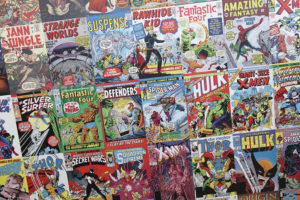On August 14, DC Comics CCO Jim Lee said something that in any other era might seem unthinkable: “We’re still in the business of publishing comics.”
That reassurance came in an interview with The Hollywood Reporter, shortly after news broke that the legendary superhero powerhouse would be cutting 20 percent of its staff. It was the latest grim headline in a series of blows to the comics industry; Marvel Comics reduced its total overhead by 50 percent in April, IDW is in the midst of an ongoing contraction, and Diamond Comic Distributors, which handles the ink and paper demands for practically every publishing house in the world, is just now emerging from a quarantine-length slumber. There have been rumbling for years about the febrile state of modern comic book economics, and like so many things in 2020, the COVID-19 pandemic cracked those anxieties wide open. Every day, diehards wake up to more news about comic shops boarding up shop permanently, emblematic of what the New York Times referred to as an “extinction-level event.” It was once impossible to imagine the DC braintrust reassuring the public that Batman stories will continue to exist in print. Now, it’s a valid question to ask.
Here are the facts.
The trajectory of traditional superhero comics have become increasingly entwined with some of the biggest entertainment corporations in America. DC is owned by Warner Bros., and Marvel is famously part of Disney’s staggeringly multiversal network of franchises. It is no secret that the cash cow for both of these companies lies in film operations (for both the Marvel Cinematic Universe and the DC Extended Universe); in that sense, comic books as a cultural force have never been healthier. Tony Stark is a household name in a way that he never was during the Golden Age. But that’s exactly the problem: it is now so much more viable to make money on comics in almost every way but lining them up on bookshelves.

As the industry scrambles to recoup some of their pandemic-era losses, the traditional single-issue floppy — the Socratic ideal of what a comic book is supposed to be — has been put in the crosshairs. In May, Marvel announced that a number of their titles scheduled for physical release (Hawkeye: Freefall and Ant-Man in particular) would instead be releasing exclusively to digital platforms.
DC is doing something similar; as part of their recently unveiled Digital First program, subscribers will have access to new stories every day on their phones and tablets, rather than needing to go get them from brick-and-mortar institutions. The thinking is clear: in order to save comics, we might need to kill them first.
”Comic books are due to have major changes the way every other entertainment media has in the last two or three decades,” Augie De Blieck Jr., a longtime journalist on the comics beat, says. “Newspapers are dying. Magazines are fading from the shelves. The movie industry has suffered from a series of incidents now, but let’s start with home theaters and DVDs. Streaming disrupted both television and movies. Even video games don’t use cartridges or CDs much anymore. And what’s changed about comics in the last 30 years? Comics lost the newsstands, but that’s about it. It’s that kind of thinking that dooms all sorts of companies and industries. Apple obsoleted the iPod, itself, with the iPhone. They didn’t hobble the phone to protect the large iPod sales.”
De Blieck is echoing a talking point that’s rattled around comic book stores for years. Simply put: serialized single issues have very slim profit margins.
A standard $2.99 issue of a new Batman story does not compete with the rest of the publishing universe anymore.
Brandon Schatz, a writer and co-owner of Edmonton’s Variant Edition Comics, makes the following three arguments against the sustainability of the 24-page comic as we know it. First, he says, single issues are no longer the optimal way to deliver new comics, and the idea of going to the store every Tuesday to bring home a bounty of new stories is fundamentally archaic. Secondly, there is currently only one distributor, the aforementioned Diamond Comics, that is even willing to bring those issues to print, and the future of that company is looking increasingly up in the air. And perhaps most importantly, single issues are inherently perishable entities, they lose their value quickly and rapidly the longer they stay on the shelves. That last point was the one I asked Schatz to expand on, when I reached him for an interview.
”Each week, the major companies put their books on final order cutoff, which means retailers need to send their final orders for upcoming issues. For the most part, this window roughs out the three and a half weeks to ship the comics to retailers,” he says. “When comics come out monthly, that means a retailer has about three to five days of sales data to guess what to order next. This is made even worse if the title is a bigger character that the company wants to ship twice monthly, such as Batman or Spider-Man. The time it takes to produce the physical single issue format does not line up with the realities involved in ordering.”

It is strange to hear someone who owns a comic shop — ostensibly a business that relies on the never-ending deluge of weekly serials — advocate for abandoning that tradition altogether, but Schatz believes in a middle ground that could benefit both retailers and distributors alike. He puts forth a model where DC and Marvel release all of their stories — with their twists and turns and shocking reveals —through digital platforms first. Afterwards, those stories would be consolidated into a sturdy, 80-page issue that runs $7.99 at your local comic store. Those issues would be built around a primary main-event character — say, Batman — while a number of smaller, Gotham-adjacent characters — Nightwing, Batgirl, whoever — could each get their own arcs within the expanded real estate of the bigger comic. That way, says Schatz, the profit margins on each sale would be greatly inflated, there would be less guesswork required in determining how many issues a store would need to order, and more creative liberty could be opened up to publishers.
”The idea would be to utilize the immediacy of digital release, where you can truly surprise a reader without months of solicitation and ordering information leading up to a big reveal. That story would eventually see print in the 80-page single issues shortly after, with a retailer being able to purchase based off of legitimate excitement for the story, rather than guessing half-blind,” he explains. “It would also mean you could offer up stories when they are ready, instead of having to pump more blood into the machine just to keep things going. A character like Batman would anchor the series, but Gotham stories would cycle in and out of the printed document, and digital space, as the story requires, building a platform where those stories end up being stronger, adding value to the reader.”
That gets to Schatz’s core premise. One of the fundamental concerns with the finances of the single issue is that it creates an ecosystem where there’s an overabundance of comic books. As Schatz puts it, even the most ardent traditionalists yearn for an era where it was possible to own the entirety of the Marvel Universe without investing in more than fifty different story arcs at once. Independent outfits like Boom Studios have already begun to recognize that. The company streamlined their lineup considerably last year, and it resulted in a 63 percent bump to their total sales. A reduction in overhead might be a blessing in disguise.
”At the end of the day, there’s a way for these companies to keep telling stories in a fashion they’ve been accustomed to for years, while working with advancements in story delivery, instead of against them,” he argues. “The world is interested in what the comic industry has to offer, but they have to meet the world halfway on formatting — or else the bulk of comics will continue to run the spinning plates game until it all does come crashing down.”
Of course, there is always a chance that there will be a rebound effect in the months ahead, as the pandemic subsides. 2020 is undeniably a cataclysmic year for comic books, but John Jackson Miller, a comics writer and proprietor of the ComicChron database, mentions that 2019 was a banner year for total sales. Graphic novels did $765 million, while comic books chipped in an additional $355 million; those numbers combined represent an 11 percent increase from the total revenue generated in 2018. “There are signs that a recovery to previous levels may be what we’ll see. And that’d be more than enough,” says Miller.
Miller also doesn’t believe that a full-on digital pivot, akin to the plan that Schatz laid out, will ever bear fruit. After all, the comics-reading audience has had access to digital books for more than a decade now, and the market has consistently favored collected editions or serialized issues. In fact, according to ComicChron’s figures, digital sales of comic books represented a paltry $90 million last year. To this point, nobody has proven that readers actually want to read books on their phones and iPads at all, and that’s the tension at the heart of this dialogue. Would the end of the floppy, in some spiritual way, signal the end of a whole tradition of reading comics? Is it worth it to let that go?
“There is no comics industry as we would recognize it without print serialization.”
”At a minimum, there would be far fewer comics stories being published and far fewer people able to work in comics, because most projects only make sense when there is the additional revenue stream while the work is being produced,” Miller says. “The true circulation of comic books is far higher than any sales chart would reveal, because they change hands many times over their physical lives. Smart publishers see that, and are unlikely to give it up.”
Of course, De Blieck pushes back on Miller’s premise. Modernization has rescued so many industries. Napster seemingly devastated the music business during the early 2000s. Now, on the back of streaming services, it’s in the middle of a historic boom. Do people miss the wholesome act of stacking CD jewel cases on your bed stand? Maybe, but the culture surrounding pop music never subsided. For all we know, comics might actually be around the corner from a brand new golden age, albeit one without the single issue.
“Why do we continue to think that comics is the one media darling that will never change?” De Blieck says. “Every other form of entertainment has built up a huge digital angle, often surpassing the hard copy form. Why should comics be any different?”

